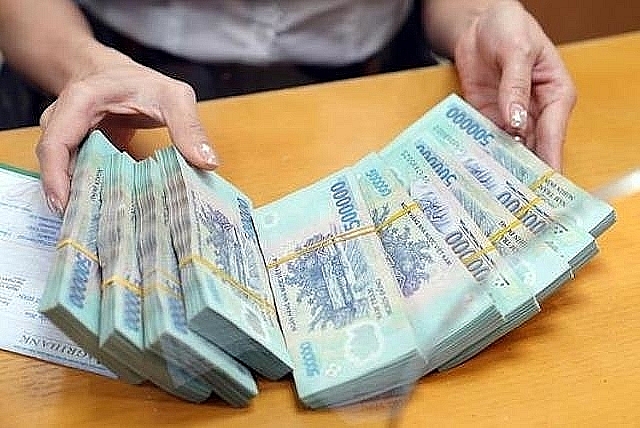Establishing a trend of decreasing interest rates for the market
The State Bank of Vietnam (SBV) has decided to further reduce some operating interest rates for the fourth time this year since June 19. This move is considered by experts to be strong and appropriate in the current context.
Abundant and redundant liquidity
Previously, on June 15, 2023, the US Federal Reserve (FED) announced to keep the interest rate unchanged at 5-5.25%/year but signaled that it could continue to tighten this year. The market forecasts the possibility that the Fed will increase one to two times interest rates in 2023.
In the first months of the year, many economic indicators increased lower than the same period of the year, reflecting the negative impact of the sharp decline in foreign demand and the internal difficulties of the economy. However, inflation continued to slow in the first five months of 2023 due to low economic growth, reducing demand-pull inflation pressure.
The State Bank said many forecasts indicate that it is quite feasible to achieve the average inflation target for the whole year of about 4.5%; International organizations forecast average inflation in 2023 at about 3%-5.5%.
Also according to the money management agency, the money market is stable, the liquidity of the credit institution system is abundant. Since the beginning of 2023, the State Bank has purchased a large amount of foreign currency to supplement foreign exchange reserves, contributing to the circulation of a large amount of VND. The above solutions have contributed to creating abundant liquidity in the market, thereby stabilizing and reducing the interest rate in the interbank market, supporting credit institutions to reduce deposit interest rates and reduce lending rates for the economy.
 |
|
Operating interest rates continue to decrease, which is expected to support businesses' recovery. Photo: Internet |
Therefore, the State Bank has adjusted the operating interest rates four times with a total reduction of 0.5-2.0%/year.
According to the State Bank of Vietnam, continuing to reduce the operating interest rates is a flexible solution, suitable to the current market conditions to realize the goal of reducing lending rates to support the process of recovering economic growth according to the policy of the National Assembly and the direction of the Government and the Prime Minister.
“The continued reduction in operating interest rates by the State Bank of Vietnam confirms and establishes a trend of interest rate reduction for the market, thereby orienting credit institutions to be bolder and more drastic in reducing lending rates and accompanying them together with businesses and people, contributing to promoting economic growth and recovery", the State Bank's report stated.
It needs to improve the effectiveness of policy coordination
Commenting on this move of the State Bank, economic expert Dr. Can Van Luc and a group of experts from the BIDV Training and Research Institute said that this continues to be a strong move, suitable for the four institutions.
Firstly, the pressure to increase interest rates and exchange rates has been significantly reduced when the FED has paused to raise interest rates, it may increase, but the total amount of increase is forecast to be only at a level. Secondly, although inflation is high, it has been decreasing since February 2023. Third, the domestic money market is basically stable, the liquidity of the banking system is more abundant, and credit demand is weak. Fourth, the socio-economic situation has many difficulties, so reducing interest rates is one of the solutions to support businesses and people to overcome difficulties and promote growth.
Therefore, according to these experts, the reduction of operating interest rates will support credit institutions in accessing capital from the SBV through tools such as rediscounting, refinancing, and interbank lending; helping credit institutions continue to reduce deposit and lending interest rates. At the same time, credit growth is expected to be more prosperous when interest rates decrease, thereby contributing to increasing income from credit and related services for credit institutions.
Moreover, reducing interest rates will help businesses mobilize new capital at lower interest rates, both contributing to increasing debt repayment capacity, reducing bad debt risks, reducing input costs, and creating favorable conditions for reducing output prices in the future. response, thereby stimulating consumption.
Dr. Can Van Luc said that changing monetary policy, from cautious to flexible, loosening will help businesses and people expect interest rates to continue to decrease, making them able to decide to invest and spend more money, contributing to supporting socio-economic recovery and development next year.
In particular, reducing interest rates will have a positive impact on the stock and real estate markets, as investors can partially shift from saving to investment with the desire to seek higher returns.
Despite many impacts, the SBV still affirmed that it would not be subjective with inflation pressure. It will continue to closely monitor domestic and international developments, inflation forecast and market interest rates to continue to monitor credit institutions to have cost-saving solutions to reduce lending interest rates.
Sharing the same opinion, but to be more effective, experts of the BIDV Training and Research Institute suggested that it is necessary to improve the effectiveness of policy coordination, especially between monetary policy, fiscal policy, price and other policies. Other macro policies aimed at proactively controlling inflation and stabilizing the macro-economy. Along with that, it is necessary to accelerate the restructuring of weak credit institutions and be more drastic in improving the business and investment environment.








